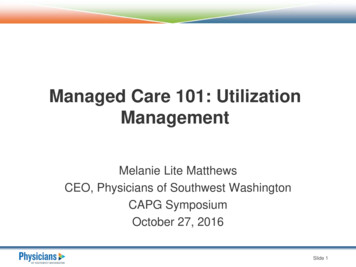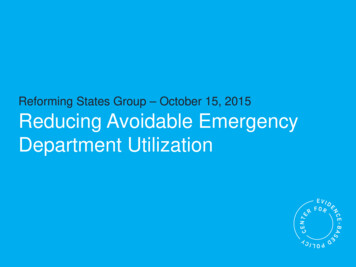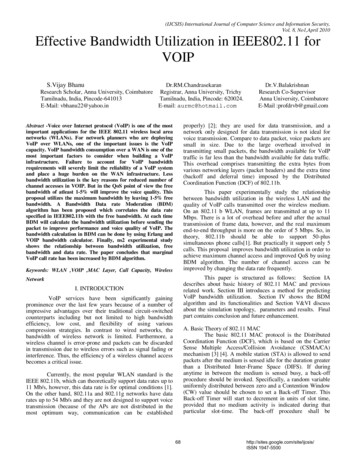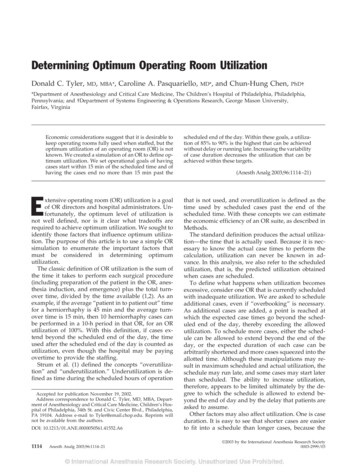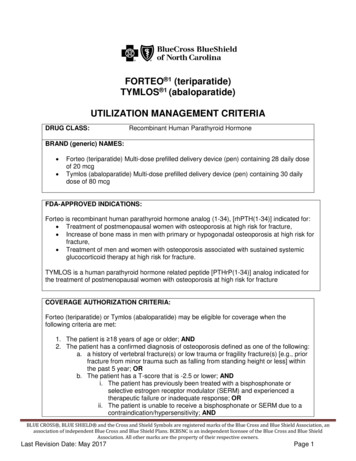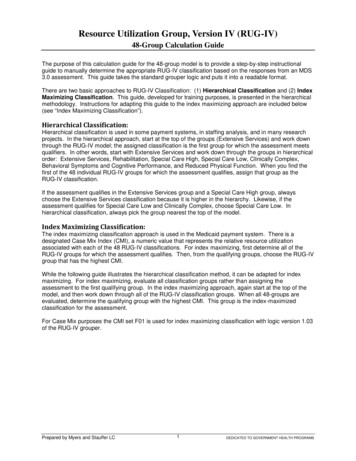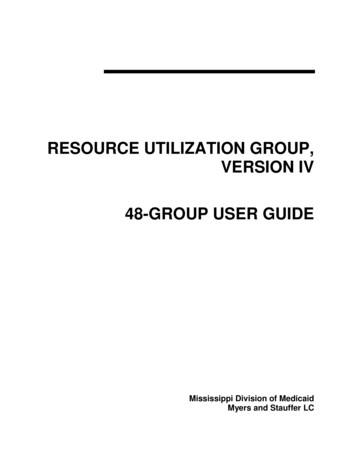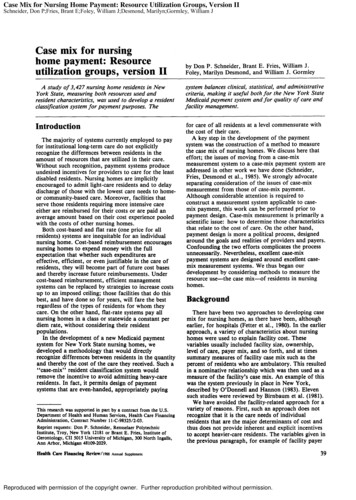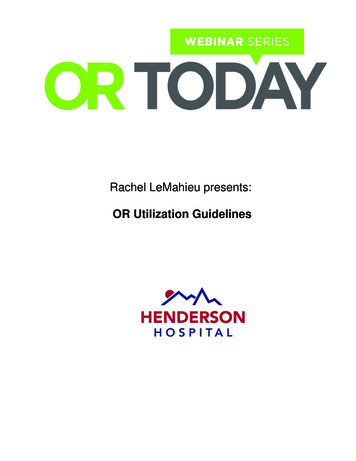
Transcription
Rachel LeMahieu presents:OR Utilization Guidelines
Thursday, December 7, 2017, 2:00pm ETPRESENTER: RACHEL LEMAHIEURachel LeMahieu, MSN, RNFA, CNOR, is the Director of Surgical Services, CathLab, and Specials at Henderson Hospital in Henderson, Nevada. Rachel receivedher BSN from the University of Wisconsin, Madison and her MSN at GonzagaUniversity in Spokane, Washington.Rachel is responsible for the clinical, financial, and administrative functions of theoperating room, pre-admit testing center, recovery room, pre-operative area,anesthesia, lithotripsy, sterile processing department, cath/specials lab, andendoscopy.Rachel has 17 years of experience in the Operating Room ranging from circulator, scrub, RNFA,educator, charge nurse, manager, and director. She has lead Lean processes and Surgical SiteInfection Bundle implementations at her facilities. Rachel was the team lead for the SUSP program atSpring Valley Hospital. Her latest project was the opening of Henderson Hospital Outpatient SurgeryDepartment in the innovative medical community of Union Village.WEBINAR AGENDA:During the 60-minute presentation Rachel will be discussing enhancing OR use with modified blockscheduling techniques, policy revision for block scheduling, capturing surgeon buy in for blockoptimization and using your resources for sustaining change in block allocation and utilization.Click here to why you want to attendOur presenter looks forward to addressing your questions. Attendees will beon a listen only mode throughout today’s presentation, but you are able tosubmit a question during the webinar using the “Questions” or “Chat” featureon your webinar dashboard.You are welcome to submit your questions prior to today’s webinar. Pleaseemail webinar@mdpublishing.com with the subject line“Attendee Question for OR Today’s Webinar.”
SAVETHE DATEAUGUST 26-28, 2018RENAISSANCENASHVILLE HOTELwww.ortodaylive.com
WEBINAR SERIESPolicy Title:Location:Department:Surgical ServicesPolicy Number:Review Due:September 2019Original EffectiveDate:I.Operating Room Utilization GuidelinesSeptember 2016Reviewed Dates:Scope:Medical StaffII.Purpose:To promote optimal use of available OR time and to ensure that surgeons who are consistent users ofthe facility have regular access to available OR time.III.Policy:The department of surgical services will use a modified block scheduling format. A modified blockprovides physicians/physician groups the opportunity to have assigned times for scheduled cases.This guideline provides a mechanism for surgeons who are infrequent users or newcomers the ability toacquire available block time or to use open time on a first-come/ first-served basis. Block time will beassigned to physicians/physician groups showing the highest utilization of available OR time. Blocktime will be limited so as not to exceed 75% of available OR time during normal operations. Requeststhat exceed the 75% in total will not be approved.DEFINITIONS:Modified Block Schedule: This type of block allows for some “open” time and provides a release timeprior to the surgery date.Hours of Operation: This is the time available for elective surgical procedures to be performed.In and Out Time: This is the total room time and is calculated from the time the patient enters theroom until the time the patient leaves the room. This time will be used to calculate utilization.Turnover Time: This is the time for room clean up and preparation between cases. This time will notbe used to calculate utilization.Start Time: This is the time the patient arrives in the procedural suite.Block Utilization Committee: This committee consists of the CEO, the Director of Surgical Servicesand designees.Late Case Starts: Any case that has not started within 5 minutes of the scheduled start time will be
WEBINAR SERIESconsidered late and may be moved to the end of the schedule.Physician Arrival Time: All surgeons should be in the surgical suite ready to scrub fifteen (15) minutesbefore the scheduled starting time of the operation. If the surgeon fails to arrive in the surgical suiteby the scheduled starting time for his case, the case will be placed at the end of the schedule and thenext case will be moved up. A surgeon or anesthesiologist who has a 7:30 a.m. case scheduled mustbe in the Operating Room by 7:15 a.m. on the morning of the surgery. If this rule is not followed, thesurgeon or anesthesiologist will not be allowed to schedule 7:30 a.m. cases in the future.IV.Procedure:All requests for block time must be submitted in writing to the Director of Surgical Services.The hours of block scheduling will be assigned per each physician or physician group and cover either afour, six, eight, or ten hour block. The number of procedures scheduled must fit into that time allotment, and procedures must be scheduled to finish within the allotted block time.Scheduling:All scheduling within the block time will be done through the surgery scheduler.There will be one room available each day for urgent, emergent and first-come, first-served cases.Elective cases for the next day may be scheduled until noon, provided time is available during hoursof operation.All cases scheduled after noon, prior to day of surgery, will be considered add-ons for block schedulepurposes.Blocks will be released based on the following Tier utilization-based program before the scheduleddate. This block time utilization percentage must be maintained for a period of three months inorder to qualify for a Tier upgrade.Tier I block start.80% block time utilization. Block released in system 24 hours prior to scheduledTier II block start.70-79% block time utilization. Block released in system 72 hours prior to scheduledTier III block start.below 70% block time utilization. Block released in system 7 days prior to scheduledFormula used for calculating block time utilization:% Utilization Total Room Time UsedBlock Time Available – Turnover TimeA physician may release established blocks or any part of a block to “open scheduling” at any time. If
WEBINAR SERIESan established block is not utilized and has not been released by the physician within the designated Tier release time, utilization will be calculated at 0%. Physicians who release blocks on a routine, patterned basis will be subject to Block Utilization Committee review and revision of block timeaccordingly. Planned vacations are to be submitted no less than 30 days prior to vacation start toenable other providers to utilize available surgical time.All utilization data will be presented to the Block Utilization Committee for review. Block time will bereviewed and managed on a monthly basis.Corrective Action:To retain block time, an overall 80% utilization of allotted block time must be achieved. If utilizationfalls below 80% in one month, the physician will be notified in writing and corrective action taken.1. The first level of corrective action is to move the physician’s release time to the appropriateTier based on their block time utilization rate.2. The second level of corrective action will be a reduction of the physician’s block based oncurrent use rate sufficient to result in 80% block use. For example, if a physician’s utilizationis at 55%, a 25% reduction of block time will be implemented to result in 80% utilization.3. The third level of corrective action will be a cancellation of block time if 80% utilization cannotbe achieved, once all other measures have been exhausted. Reinstatement of cancelled blocktime is subject to availability and approval by the Block Utilization Committee. Requests forreinstatement of block time must be submitted to the Director of Surgical Services.All monthly utilization data will be presented to the Block Utilization Committee for review. TheBlock Utilization Committee will review compliance with Operating Room Utilization Guidelines policymonthly. The committee will make adjustments as deemed necessary to block time to ensure maximum efficiency in the Surgical Services Department.During the calculation of times, the following circumstances will be factored into the utilization andsurgeon findings:1. Physician blocks are moved to different rooms, and both will receive credit.2. The block is bumped by an emergency case. This time will not be counted as non-utilization.3. Timely release of all or part of a block.4. Turnover time is not included in utilization calculation.
WEBINAR SERIESPolicy Title:On Time First Case Start GuidelinesLocation:I.Department:Policy Number:SReview Due:Original EffectiveDate:September 2016Reviewed Dates:PerioperativeServicesSeptember 2019Scope:Medical StaffII.Purpose:To promote optimal use of available OR timeIII.Policy: The Department of Surgical Services will use a guideline for First Case Start Times to allow foroptimal use of the procedural areas and provide the highest quality of care and service to the customers it serves.Definitions:First Case: The First Case in each room, each day that is scheduled to start between 6am and 3pm,Monday through Friday, excluding add-ons, emergent or urgent cases.Start Time: Defined as the time the patient arrives (Wheels In) in the Procedural/OR suite.On time Start: Defined as the “Patient in Room Time”, and is within 5 minutes of “Scheduled Case StartTime”. .Physician Arrival Time: Defined as Physician arrival in PreOp/PreOp Holding Area fifteen (15) minutesprior to Scheduled Start time of procedure.Patient Arrival Time: Patients must be in the PreOP/PreOP Holding areas a minimum of1 hour prior toScheduled Start times. If Patient is late arriving and not ready 1 hour prior to Scheduled Start time,Clinical Supervisor and/or Director must be notified and a MIDAS completed.IV.Procedure:A.Physicians will notify Preop RNs upon arrival with arrival time noted and recorded on trackinglogs in respective Preop/PreOp Holding Areas. Notification of arrival times and accurate documentation is vital to ensure accuracy of data reporting.B.If a physician is greater than thirty (30) minutes late for a scheduled start time and will cause a
WEBINAR SERIESsubsequent physician’s case to be late, the case may be moved to the next available time slot.C.The patient will be notified of the delay and notified of the rescheduled start time.D.The RN will enter a Midas regarding the delay for peer review.E.The first scheduled case must have completed the PAT (pre-admit test) process or a completechart as defined by the Medical Staff Rules and Regulations (Section 5 Surgical Care, MandatoryPre-Operative Evaluation and Documentation). If incomplete, the case line up may be reorderedto allow for a patient that has met the above criteria to be the first case.
WEBINAR SERIESJanuary 2, 2014Dear Dr. X: Fax: 702-889-XXXXWe are providing you with your monthly block utilization rate. Also, we began monitoring first case ontime starts for the month of December and are reporting this data to you in this letter.Reminder of the block utilization policy’s key components:Tier Utilization ProgramBlocks will be released based on Tier utilization before the scheduled date. Tier utilization rates must bemaintained for a period of three months in order to qualify for a Tier upgrade.Tier I 80% block time utilization. Block releases automatically in system 24 hours prior toscheduled block start.Tier II 70-79% block time utilization. Block releases automatically in system 72 hours prior toscheduled block start.Tier III below 70% block time utilization. Block releases automatically in system 7 days prior toscheduled block start.Formula used for calculating block time utilization:% Utilization Total Room Time UsedBlock Time Available – Turnover TimeEffective January 1, 2014, we have initiated Level One corrective action for underutilized blocks, with Tieradjustments based on utilization rates for the month of December. Beginning in February 2014, Level Twocorrective action will be initiated based on block usage patterns. This may result in an adjustment to blocktime available to achieve the 80% utilization rate. For example, if a physician’s block utilization rate is 55%for the month, a 25% reduction of block time available will achieve the policy goal of 80% usage of allottedblock time. If you continue to have difficulty meeting the 80% utilization rate, please contact our schedulerat 853-3455 to discuss options for increasing your block utilization.As of December 31, 2013:Your block utilization rate for Tuesday is 53%Your block utilization rate for Friday is 91%On time first case start ratio is 90%
WEBINAR SERIESIn accordance with the Block Utilization Policy, on Tuesday and Friday your block will remain on a 7-dayrelease for the month of January 2014.We appreciate your support of our hospital’s surgery department and look forward to working with youto make your block time as productive and convenient as possible. Please do not hesitate to contact usregarding any concerns you may have.Sincerely,Rachel LeMahieu Leslie BuchananDirector of Surgical ServicesOperating Room Manager702-853-3046 702-853-3464
WEBINAR SERIESJanuary 2, 2014Dear Dr. X: Fax 702-216-XXXXWe are providing you with your monthly block utilization rate. Also, we began monitoring first case ontime starts for the month of December and are reporting this data to you in this letter.As of December 31, 2013Your block utilization rate for Wednesday is 88%Your block utilization rate for Friday is 98%On time first case start ratio is 90%Thank you for being an active member of our surgical team!Your block release will remain at a Tier I which releases automatically in the system 24 hours prior to thescheduled block start. Tier I requires a minimum of 80% block time utilization.We appreciate your support of our hospital’s surgery department and look forward to working with youto make your block time as productive and convenient as possible. Please do not hesitate to contact usregarding any concerns you may have.Sincerely,Rachel LeMahieu Leslie BuchananDirector of Surgical ServicesOperating Room Manager702-853-3046 702-853-3464
WEBINAR SERIESSeptember, 2013Dear Dr. XOur hospital values its working relationship with you and strives to continue to provide the best possiblesurgical experience for you and your patients. In an effort to improve efficiencies and to accommodateOR block time as well as ensuring we are able to schedule cases on an urgent or emergent basis, we haverevised the block utilization policy. The purpose is to assure that time is set aside for those who prefer blocktime for the convenience of their practice. We appreciate your support in understanding the need to havemore consistent and efficient use of our block time.Attached is our hospital’s revised block utilization policy for your review. A few the most important changesto the policy is a decrease in the utilization rate from 90% to 80% a Tier Utilization Program for block releasetimeframes, and a 30 day notice for block release due to provider vacation. This change was approved bythe hospital’s Surgery committee and is required to maintain your block privileges.Tier Utilization ProgramThe block will be released based upon the following Tier utilization based program before the schedule date.This block time utilization percentage must be maintained for a period of three months in order to qualify for a Tierchange.Tier I 80% block time utilization - Block released in system 24 hours prior to scheduled block start.Tier II 70-79% block time utilization - Block released in system 72 hours prior to scheduled block start.Tier III below 70% block time utilization - Block released in system 7 days prior to scheduled block start.Formula used for calculating block time utilization:% Utilization Total Room Time UsedBlock Time Available – Turnover TimeA physician may release established blocks or any part of a block to “open scheduling” at any time. If anestablished block is not utilized, and has not been released by the physician within their designated Tierrelease time, utilization will be calculated at 0%. Planned vacations are to be submitted no less than 30days prior to vacation start to enable other providers to utilize available surgical time.We will be providing you with updated reports, and block time will be reviewed and managed on a routinemonthly basis. To help you make the best use of your allocated block time, may we suggest the following: Verify that patients are scheduled within your block time.
WEBINAR SERIES Provide the hospital with appropriate policy driven notice if you are unable to use your block time oryou are going on vacation. This allows us adequate time to schedule other cases. Start the first case of your scheduled block on time.If you continue to have difficulty meeting the 80% utilization rate, please consider taking at least one of thefollowing steps: Reduce your block time. Reduce the number of days you have blocks. Change your start time if your cases consistently begin late.Please remember that your block time will be reduced if you have not scheduled a case within yourdesignated Tier’s block time release. This allows the hospital to accommodate urgent, emergent and firstcome, first-served surgeries. In accordance with the policy, your block time requests will be cancelled ifwe see consistent under-utilization, but we will communicate any problems we observe so you can takeappropriate steps to address them.Your current block utilization rate for DAY is xxx%Your current block utilization rate for DAY is xxx%We appreciate your support of our hospital’s surgery department and look forward to working with youto make your block time as productive and convenient as possible. Please do not hesitate to contact usregarding any concerns you may have.Sincerely,Rachel LeMahieu Leslie BuchananDirector of Surgical ServicesOperating Room Manager702-853-3046 702-853-3464Attachment-Policy
WEBINAR SERIESPolicy Title:Scheduling of Surgical ProceduresLocation:Department:Surgical ServicesSeptember 2019Policy Number:LReview Due:Original EffectiveDate:September 2016Reviewed Dates:I.Scope:Surgical ServicesII.Purpose:Provide guidelines for efficient utilization of the surgical suites while providing quality patient careand accommodating surgeon’s needs.III.Policy:The surgical services department is responsible for the scheduling of all elective cases for the Operating Room/G.I. Endoscopy suites/Cath Lab/Specials. The surgical services personnel are responsibleto schedule cases as accurately as they can, taking in to consideration time, personnel, and equipment requirements. Every effort shall be made to accommodate physician requests, if possible.IV.Definitions:A. Start time: The time the patient arrives in the procedural suiteB.Emergency case: A case that would result in the potential for increased morbidity/mortality. The physician declares the need for an emergency.C.Bumping: An elective case may be bumped for an emergency case. The physician declaring the emergency must notify the physician of the case being bumped.D. Late case: Any case that is delayed more than 5 minutes past scheduled start time.E.Physician arrival time: All surgeons should be in the surgical suite ready to scrub fifteen (15)minutes before the scheduled starting time of the operation. If the surgeon fails to arrive inthe surgical suite by the scheduled starting time for his case, the case will be placed at theend of the schedule and the next case will be moved up. A surgeon or anesthesiologist whohas a 7:30 a.m. case scheduled must be in the Operating Room by 7:15 a.m. on the morning ofthe surgery. If this rule is not followed, the surgeon or anesthesiologist will not be allowed toschedule 7:30 a.m. cases in the future.
WEBINAR SERIESV.Procedure:A.Scheduling (Elective)1.Scheduling will usually be performed by the scheduler in the operating room. However,same day (add-ons) or next day cases may be schedu
Medical Staff II. Purpose: To promote optimal use of available OR time III. Policy: The Department of Surgical Services will use a guideline for First Case Start Times to allow for optimal use of the procedural areas and provide the highest quality of care and service to the custom-ers it serves. Definitions:
